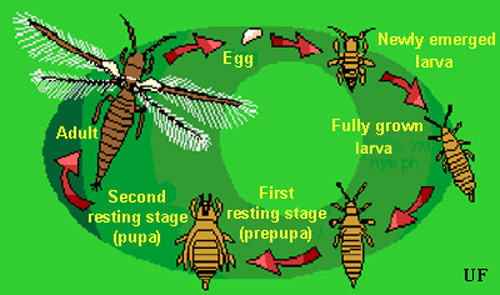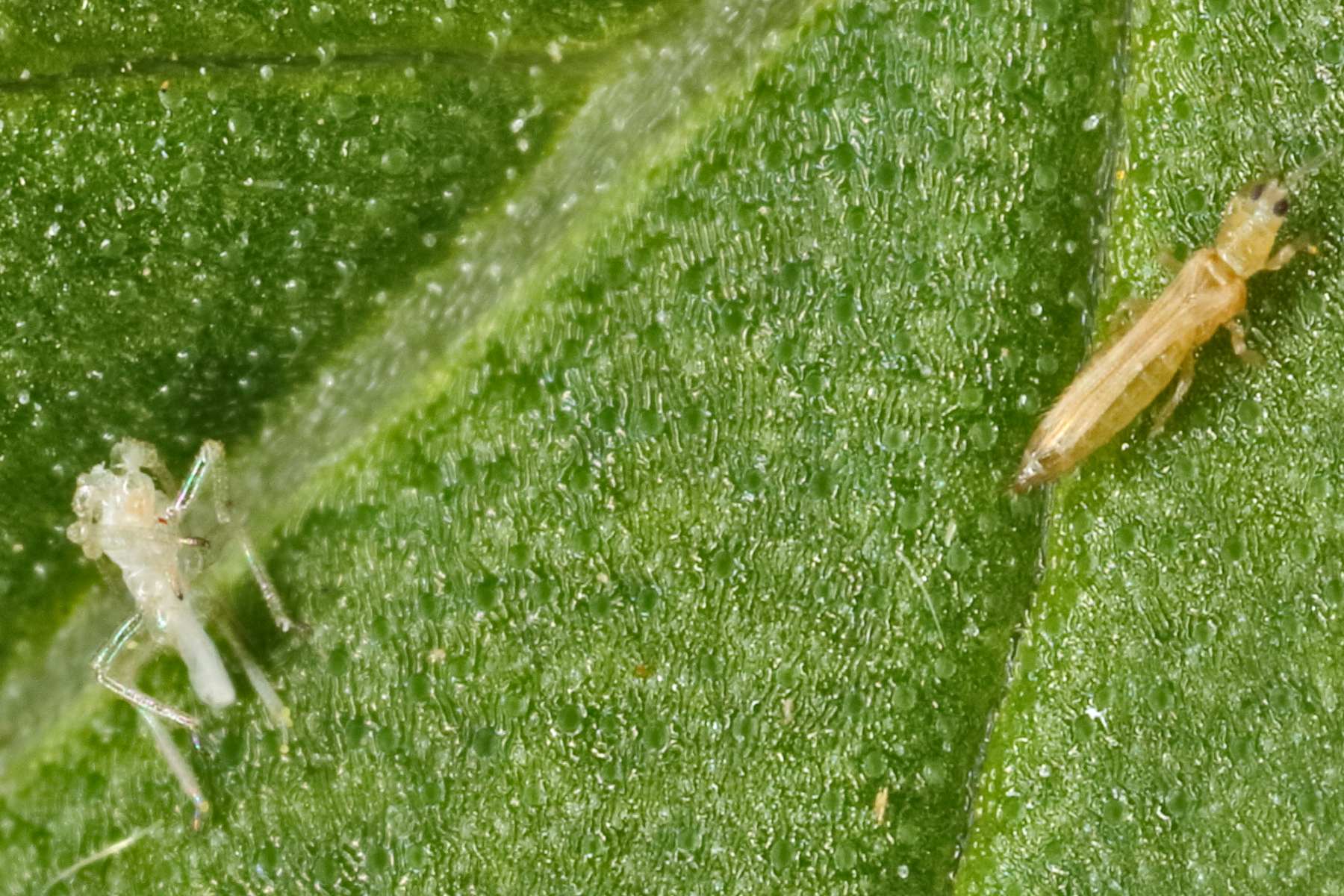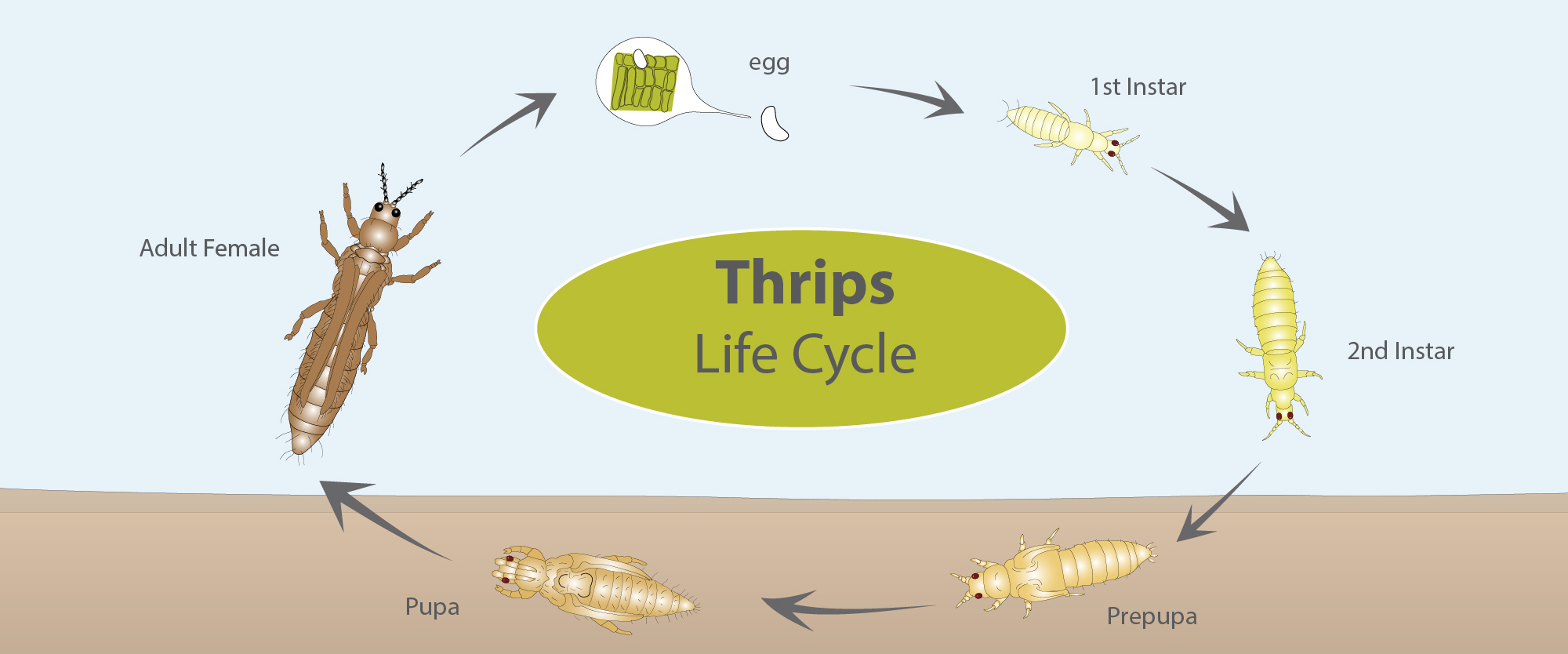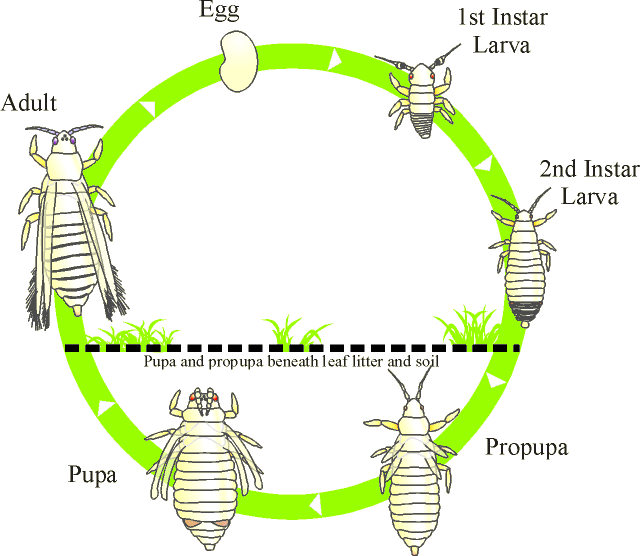citrus thrips life cycle
Trips de los cítricos. The thrips life cycle begins in the egg stage before the thrips hatch and begin development.

Western Flower Thrips Management And Tospoviruses Greenhouse Aphids Life Cycles
They lay their eggs singly or in clutches on plants leaves and other areas such as flower buds and fruits.

. Thrips commonly found in citrus are shown on page 4. Thrips can survive like this as adults pupae or eggs. Together all stages from nymph to adult require at least 7 days and at most 15.
Were plague thrips Thrips imaginis which will not damage fruit. Eggs once lain incubate for 2 to 16 days. The appearance and biology of Euseius species are virtually the same.
Diapause is almost like suspended animation. First-instar nymph second-instar nymph prepupa pupa adult eggs Figure 9. Eggs inserted into the plant tissue by the females sharp egg-laying tube ovipositor hatch in about 6 days.
Thrips Life Cycle When a female is unable to find a mate asexual egg production occurs. When food is suboptimal and the weather is colder the life cycle can be 45 days. Thrips can be monitored using yellow sticky paper and controlled with the help of natural predators proper weed management plant covers and reflective mulch.
Because thrips are tiny identification using a hand lens may be very difficult. Thrips are believed to have descended from a fungus-feeding ancestor during the Mesozoic and many groups still feed upon and inadvertently redistribute fungal spores. Then the prepupal and pupal stages take an additional 4 days and generally occur in the soil.
When monitoring citrus thrips you must be able to distinguish them from flower thrips which feed on flower parts but do not damage citrus. Typical thrips life cycle. All three thrips species have alternate hosts in Florida including various weed species with-in citrus groves.
Eggs are long and cylindrical and are laid on leaves buds or other locations where emerging larvae may be able to feed. These live among leaf litter or on dead wood and are important members of the ecosystem their diet often being supplemented with pollen. For most thrips species the duration is two weeks.
This provides the eggs with protection from predators and unfavorable weather conditions. The average life span of a mated female is about 35 days and. They can produce 8 to 12 generations during the year if the weather is favorable.
A distinctive feature is that the pupae are found on leaves in leaf litter in axils of leaves or under calyces of flowers and fruit. Two larval stages require about 6 days for completion. Scirtothrips clivicola Hood 1957.
Each female lays 20 to 50 eggs at a rate of 2 to 3 a day depositing them on both sides of leaves. Preferred Common Name. Thrips Habitat Thrips can be found in all regions of North America.
During the summer in southeast Florida flower thrips can attain maturity in 11 days and have 12 - 15 generations per year. They hatch into the first nymph. The life cycle from egg to egg may be as short as 12 days during warm weather.
A female thrip can produce up to 80 eggs per cycle. Citrus thrips do not develop below 58F 14C. Eggs inserted into the plant tissue by the females sharp egg-laying tube ovipositor hatch in about 6 days.
Once hatched the thrips life cycle continues as they begin consuming plant matter. Appearance and life cycle of Citrus thrips When food availability is optimal the life cycle lasts 20 days during October and November. The male is smaller and has a tapered abdomen.
In the thrips life cycle egg-to-adult development takes about 16 days. Two larval stages require about 6 days for completion. Adult female citrus red mites are oval and globular.
Once they have reached the end of their nymph development they will pupate and become adult. Eggs are laid in soft leaf tissues or young fruit and can take 6-24 days to hatch depending on temperature. Some varieties can enter diapause.
Generations of thrips per year From egg to adult only 9 days to 1 month separate one generation from the next. Thrips have an unusual life cycle that starts with hatching from an egg and then going through two feeding larval stages followed by two non-feeding stages called the pre-pupa and pupa. Season The average number of days for KCT to complete a generation Spring and Autumn 25 -28 Summer 14 Winter 70 -80 KCT are in greatest abundance in citrus during flowering.
This process can take 8-15 days during warm weather and as long as a month in colder weather conditions. There are two larval stages in which feeding occurs and two non feeding stages. Then the prepupal and pupal stages take an additional 4 days and generally occur in the soil.
Unlike most caterpillar species thrips eat a hole in the plant to lay eggs. The insect feeds on the plant during the first and second larval instars and adult stage of its life cycle. Thrips live about 45 days and those that are born late in summer will go into diapause until the spring so the species can continue to thrive in the following spring.
The pre-pupa and pupa are found in the soil and do not feed. Thrips begin their life cycle by laying extremely tiny eggs which are usually around 002mm. The prepupa and pupa stage.
Life Cycle of Thrips. It is an important biological control of spider mites but only assists with control of citrus thrips and does not always reduce thrips populations below an economic threshold. The thrip life cycle takes approximately 2 weeks completes and consists of an egg stage a feeding larval stage non-feeding prepupal and pupal stages and finally an adult stage.
The time taken to complete their life cycle ranges from as little as two weeks in mid-summer to 25 3 months in winter. Look for them in. In the thrips life cycle egg-to-adult development takes about 16 days.
It then enters a pre-pupal stage and later a pupal stage during which it does not feed. The larva emerges from eggs deposited on the host plant and feeds during its first two larval stages. Therefore no action was taken.
Euthrips citri Moulton 1909. Effective insecticidal control options currently labeled for citrus are limited to Danitol 24EC sprayed at con-. Thrips californien des agrumes.
Completes its entire life cycle within the tree canopy either between touching fruit or between leaves or twigs and touching fruit.

Thrips In Citrus Agriculture And Food

Melon Thrips Thrips Palmi Karny

Lifecycle Of Thrips From Egg To Instar To Adult In Under 10 Days

The Life Cycle Of Thrips Youtube

Welcome To The Fruit Vegetable Ipm Lab At The University Of Florida Species University Of Florida Fringed

Life Cycle Of Kelly S Citrus Thrips Pezothrips Kellyanus Life Cycle Of Download Scientific Diagram


